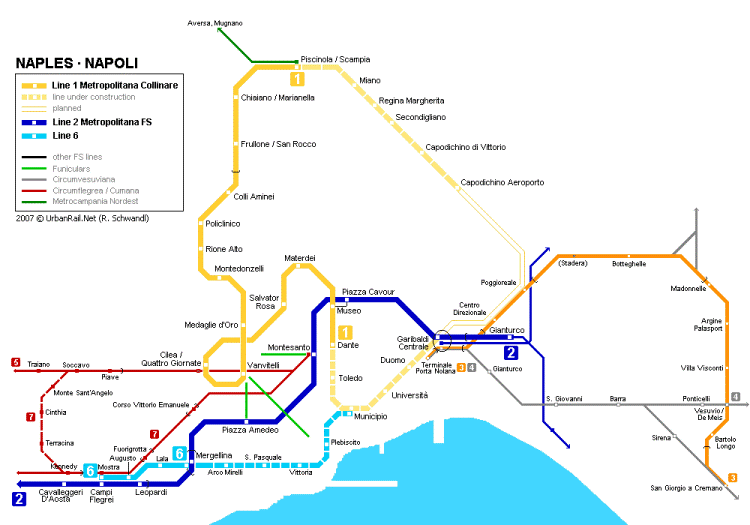Special offersBook directly with us
Bored of usual gifts? Give an emotion
BUY NOW our gift vouchers available at any time of the year.
Valid for 2 years

Book now directly with us, for you many benefits - Best price online - Free WiFi - Free luggage storage - Tour ticket sales - Automatic hot drinks machine free all day long - Priority early check in

Add our Romantic Package to your stay! Only 60€ to give an emotion.
Romantic Package includes: aperitf & bottle of wine/prosecco, room light with ligthers only, petals everywhere in your room.

Come to Naples to celebrate your birthday, for you a bottle of wine for free.

ANM Lines 1 and 2 of the underground and 4 funiculars of Naples (Centrale, Chiaia, Mergellina and Montesanto) form the current railway of transports managed from Metronapoli, integrated from the three systems of escalator, that make easyer and shorter the connection between the stations of Vanvitelli (Line 1), Funicular Central, Chiaia Funicular and the Montesanto Funicular. Certainly the best way to go around in Naples.
Unico Campania One ticket to go around in naples or in all campania! Find out what's the best solution for you and discover advantages of Artecard...museums and transports with one ticket!
www.anm.it To know the way of all city buses.
Info Click Check bus timetable real time
SepsaBuses and trains to reach the Campi Flegrei.
Circumvesuviana The faster way to reach Pompei, Ercolano and Sorrento.
CAPPELLA SANSEVERO: Via Francesco De Sanctis, 19 - Tel 081-5518470
Open everyday from 9.00am to 7pm Closed on Tuesday
Bus: C57, R2
CAPPELLA DEL MONTE DI PIETÁ : Via San Biagio dei Librai, 114
Open on Saturday from 10am to 6pm. Sunday from 10am to 2pm
Bus: C57, R2
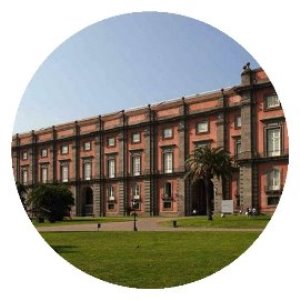
CAPODIMONTE : Via Miano, 2 - Tel. 081-7499111
Open from 8.30am to 7.30pm. Closed on Wednesday.
Bus: C57, R4, C63 - Shuttle City Sightseeing
CIVICO DI CASTELNUOVO: Maschio Angioino Piazza del Municipio - Tel 081-4201241
Open from 8.30am to 7pm. Closed on Sunday.
Funicular: Centrale stop Augusteo
Metro: Line 1 stop Municipio
Bus: R2, R3, C25
CITTÁ DELLA SCIENZA : Via Coroglio, 104 - Tel 081-3723728
Open everyday from 10am to 4pm. Closed on Monday.
How to reach Città della Scienza
COMPLESSO SAN LORENZO MAGGIORE : Piazza San Gaetano, 316 - Tel 081-2110860
Open from Tuesday to Saturday from 9.30am to 5.30pm. Sunday from 9.30am to 1.30pm. Closed on Monday.
Historical center - Limited traffic zone
CORALLI E CAMEI : Piazzetta Matilde Serao, 19 - Tel 081-421111
Open on Monday and Friday from 4.30pm to 7.30pm - Tuesday and Saturday from 10.30am to 1.30pm. Need reservation.
Funicular: Centrale stop Augusteo
Metro: Line 1 stop Toledo
Bus: R2, C25, R3
DIEGO ARAGONA PIGNATELLI CORTES : Riviera di Chiaia, 200 - Tel. 081-7612356
Open everyday from 8.30am to 5pm. Ckised ib Tuesday.
Funicular: Chiaia stop Parco Margherita
Metro: Line 2 stop Piazza Amedeo
Bus: 140, 152, R3, C18, C19, C12

DIOCESANO DI NAPOLI - CHIESA DONNAREGINA NUOVA : Largo Donnaregina - Tel. 081-5571365
Open Monday to Saturday from 9.30am to 4.30pm - Sunday from 9.30am to 2pm. Closed on Tuesday.
Metro: Line 1 stop Museo - Line 2 stop Cavour
Bus: R2
DUCA DI MARTINA - VILLA FLORIDIANA : Via Cimarosa, 77 - Tel. 081-5788418
Open from 8.30am to 7pm. Closed on Tuesday
Funicular: Centrale stop Piazza Fuga, Chiaia stop Vomero
Metro: Line 1 stop Vanvitelli
Bus: C28, C31, C32
ETNOPREISTORIA : Castel Dell' Ovo- Borgo Marinari - Tel 081-7645343
Open from Monday to Friday from 10am to 1pm. Need reservation. Closed Saturday and Sunday.
Bus: R3, 140
FERROVIARIO NAZIONALE : Via Pietrarsa - Tel 081-472003
Open Thuerday from 2pm to 8pm - Friday from 9am to 4.30pm - Saturday, Sunday and holidays from 9.30am to 7.30pm.
Train: FS - Stazione Pietrarsa S. Giorgio a Cremano
Bus: 157 - 254 - 255 -256 stop Napoli-Pietrarsa
FISICA : Via Mezzocannone, 8 - Tel 081-2536222
Open Monday and Thuersday from 9am to 1.30pm and from 2.30pm to 4.45pm. Closed on Saturday and Sunday
Metro: Line 1 stop Università
Bus: R2
GALLERIA DELL' ACCADEMIA DELLE BELLE ARTI : Via Costantinopoli - Tel 081-5510547
Metro: Line 1 stop Dante
Bus: C57
IPOGEO DELLA CHIESA DEL PURGATORIO AD ARCO : Via dei Tribunali - Tel 081-446810
January – March: Monday to Friday and Sunday 10am to 2pm,Saturday 10am to 5pm. April -December: Monday to Saturday 10am to 6pm, Sunday 10am to 2pm
Historical centre - limited traffic zone
MANN - MUSEO ARCHEOLOGICO NAZIONALE : Piazza Museo, 19 - Tel. 081-4422149
Open everyday 9am to 7.30pm. Closed on Tuesday.
Metro: Line 1 stop Museo, Line 2 stop Cavour
Bus: C57, R4, C63
MADRE : Via Settembrini, 79 - Tel 081-19313016
Monday to Saturday 10am to 7.30pm - Sunday 10am to 8pm. Closed on Tuesday.
Metro: Line 1 stop Museo, Line 2 stop Cavour
Bus: E1
MUSA -MUSEO UNIVERSITARIO DELLE SCIENZE E DELLE ARTI : Via Armanni, 5 - Tel 081-5666010
Monday to Friday on appointment
Bus: R2
MUSEO DEL MARE : Via Pozzuoli, 5 - Tel 081-6173749
Monday to Friday 9am to 1pm and 3pm to 7pm - Saturday 9am to 1pm. Closed on Sunday.
Train: Cumana
Bus: R7
ORTO BOTANICO : Via Foria, 223 - Tel 081-455654
Monday, Wednesday, Friday 9am to 2 pm - Tuesday and Thursday 9am to 4pm. On Appointment. Closed on Saturday, Sunday and holidays.
Metro: Line 2 stop Cavour
Bus: 203, 254
OSSERVATORIO DI CAPODIMONTE : Via Moiariello, 16 - Tel 081-5575111
On appointment.
Bus: C63
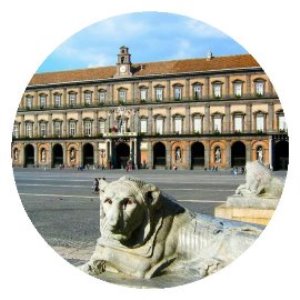
PALAZZO REALE : Piazza del Plebiscito, 1 - Tel 081-400547
Open everyday from 9am to 7pm. Closed on Wednesday
Metro: Line 1 stop Toledo
Funicular: Centrale stop Augusteo
Bus: 140, 152,R2, R3, C18, C19, C12
PAN - PALAZZO DELLE ARTI NAPOLI : Via dei Mille, 60 - Tel 081-7958605
Open everyday from 9.30am to 7.30pm - Snday from 9.30am to 2.30pm. Closed on Tuesday.
Funicular: Chiaia stop Parco Margherita
Metro: Line 2 stop Piazza Amedeo
Bus: R3
PIO MONTE DELLA MISERICORDIA (church and exhibition of paintings) : Via dei Tribunali, 253 - Tel 081-446944
Monday to Saturday from 9am to 6pm - Sunday from 9am to 2.30pm
Historical center, limited traffic zone
QUADRERIA DEI GIROLAMINI : Via Duomo, 142 - Tel 081-294444
Monday to Friday 8.30am to 7pm - Saturday and Sunday 8.30am to 2pm. Closed on Wednesday.
historical center, limited traffic zone
SAN MARTINO : Piazzale San Martino, 5 - Tel. 081-5586408
Everyday from 8.30am to 7.30pm. Closed on Wednesday.
Funicular: Montesanto stop Via Morghen, Centrale fermata stop Fuga, Chiaia stop Vomero
Metro: Line 1 stop Vanvitelli
Bus: V1
SANTA CHIARA : Via Santa Chiara, 49/c - Tel 081-19575915
Monday to Saturday 9.30am to 5.30pm- Sunday 9.30am to 2.30pm
Historical Center, limited traffic zone
STORICO MUSICALE CONSERVATORIO DI SAN PIETRO A MAJELLA : Via San Pietro a Majella - Tel 081-446810
Monday to Friday 9.30am to 12.30pm. On appointment. Closed on Saturday and Sunday.
Metro: Line 1 stop Dante
TEATRO SAN CARLO : Via San Carlo - Tel 081-5534565
Guided tours everyday at 10.30, 11.30, 12.30, 2.30, 3.30, 4.30.
Metro: Line 1 stop Toledo
Funicular: Centrale stop Augusteo
Bus: R2, C25, R3
TESORO DI SAN GENNARO : Via Duomo, 149 - Tel 081-294980
Monday to Friday 9am to 4.30pm. Saturday and holidays 9am to 5.30pm.
Metro: Line 2 stop Cavour
TESSILE E DELL'ABBIGLIAMENTO ELENA ALDOBRANDINI : Piazzetta Mondragone, 18 - Tel 081-4238368.
VOn appointment.
Funiculae: Centrale stop C.V: Emanuele
Bus: C16, E6
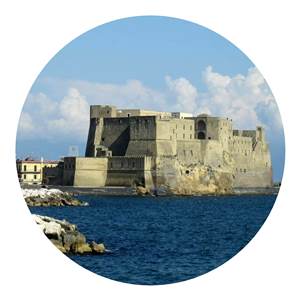
CASTEL DELL'OVO
How to reach : Reach Via Toledo from Hotel il Convento and turn on the right.In less than 5 minutes you'll be in Piazza del Plebiscito. Cross the square. Walk down Via Console for about 200 metres and turn right towards Via Santa Lucia to get to Borgo Marinari. You will find in front of you one of the most striking spectacles of fusion between Nature and human work: Castel dell'Ovo
History :
The Castle is built on the islet of Megaride, where (according to legend) the mermaid Parthenope landed and gave name to the city. By the end of the 5th century a group of monks settled in the place and founded the Cenobio of San Salvatore, whose church is still visible. In ducal times, the monks left the islet and a fortress was built in place of the old Cenobio. In the 12th century the Normans chose the site as their residence and gave the architect Buono the task of enlarging the fortress. The building of the tower called "Normandia" dates back to this period, other buildings were instead achieved by the Svevis. The present denomination of the building dates back to the 14th century. There are two different theories about its genesis: the first one concerns the particular design of the castle, which is egg-like; the other one (the most reliable one), instead, is relative to an old legend, according to which, the poet Virgilio hid a golden egg under the castle to grant stability to the islet and to the city itself. The present design of the castle is the product of the renovation made in the vice-royal age, after damages suffered in the siege of 1503. Actually Castel dell'Ovo is one of the distinctive marks of the Neapolitan sight, with its powerful walls and its arcades, that make it a monument of exceptional beauty and of great historical interest.
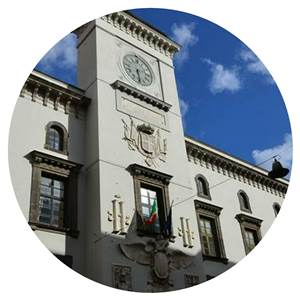
CASTEL CAPUANO
How to reach : Reach Piazza del Municipio from the Hotel il Convento (500 mts). Outside Castel Nuovo there is bus stop. Get bus R2 and stop in Umberto I - Colletta (6th stop). Walk along Via Pietro Colleta for 500 mts.
La storia :
The Castel Capuano, whose name is owed to the proximity of the ancient Door " Capuana " that introduced on the road that conducted to Capua, was built by the Normans in the 12th century. Subsequently it was widened by the Svevis, and it was one of royal palaces of the Aragonesis up to 15th century. Castle's foundation is traditionally attributed to William I. Restore by Charles I it remained a royal residences; closed in Aragonese time inside the new fencing wall, the Castle lost definitely the military character, to change in a residence. During the centuries the Castle was repeatedly restructured, and during the government of Pedro of Toledo, it was destined to entertain all courts of justice of the city, while the undergrounds were turned to jails. The Castle became so the Vicaria, the building of Justice; function that it still maintains.
The environment more interesting is the Summary Chapel "Cappella Sommaria"), with decorated walls to plasters by Pietro Ruviale in the 16th century representative Evangelical Scenes and the Universal Judgment.
Interesting is also the Saloon of the Court of Appeal, with the 18th century works of Anthony Cacciapuoti and the Saloon of the Busts, where the busts of the princes of the Forum of Naples are found.
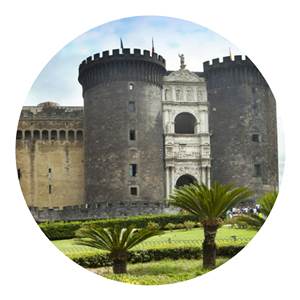
CASTEL NUOVO - MASCHIO ANGIOINO
How to reach : Outside the Hotel il Convento turn on the right and get first on the left Vico Tre Re a Toledo. At the end of the alley - about 50 mts - you'll be in Via Toledo. In front of you there is the Banco di Napoli and at the right side of the building there is Via Imbriani. Walk along Via Imbriani. At the end of the street you will be in Piazza del Municipio. Maschio Angioino Castle is in front of you.
History : Occupying Naples in 1266, Charles I of Angiò, didn't find a suitable abode, so decided to build one as soon as out of the fencing wall of the city. So works started of the Castel Nuovo started (1279-1282). It was denominated Castel Nuovo (New Castle) to distinguish others old castles Capuano and of the Ovo.Tipica representation of the French Gothic style, was initially constituted by an irregular plant quadrilateral, four towers and tall embattled walls . In reality Charles I never lived there, it was his child Charles I to establishethere and subsequently Roberto of Angio, that brought substantial changes to the structure of the Castle. When to the Angioinis succeeded the Aragonesis, also Alfonso I of Aragona followed tradition to set his abode in the Maschio Angioino (other name of Castel Nuovo) and to begin works of enlargement. Is of this time that goes up the famous arc of triumph place among the tower of middle and the one of watch. Now the monument appears a trapezoidal plant formed by a curtain of tufa in which five cylindrical towers are inserted (four of "piperno" and one of tufa). From the time of Alfonso I to today, it have been many works of amplification and restauration that have interests the castle. Substantially the structure that is introduced to our eyes today is a mixture of the French and Catalan taste.
The Arc of Triumph (1453 - 1479) : Wanted by Alfonso I of Aragon to celebrate his victorious entrance in the city (February 23 rd 1443), it's formed by 2 arcs rib of vault superimposed. The relief of the central frieze impending the first arc represents the new king sat on a wagon hauled by the Fortune. The second arc, should have instead to contain an equestrian statue of the sovereign, that should heve be order to Donatello, but in reality it was never realized.
Baron's room : Wanted by Roberto of Angiò and painted in fresco by Giotto in 1330, the room was originally called Room Maior. The frescos, unfortunately lost, represented illustrious characters of the past. In 1919 the room is partially destroyed by a fire. On the lintels are still visible the bas-reliefs represented the triumphal procession of Alfonso and the entry of the king in the castle. In the angle south-east of the Room, through a Gothic door there is the access to the spectacular winding stairs, currently inagibile. The environment is also illuminated from a balcony called "Triumphal" of which is original the base that has the form of an inverted pyramid. Currently the room is turned to the reunions of the town junta.
The legends : At the time of Charles II Of Angiò the castle was the abode of Pope Celestino V, whose pontificated was the shortest of the history: only 5 months. In fact on December 13, Celestino V decided to abandon dresses of head of the spirituality and, always among walls of the castle, was proclaimed his successor: Bonifacio VIII. The history narrates that it was the same Bonifacio VIII to convince the pope to abdicate. It is narrated, in fact, that Bonifacio, well knowing the sensitive character of Celestino, night time, introducing a long trumpet through a window in the room of Celestino, and pretending to be a messenger of God, he suggested to him to abandon the charge. Very more atrocious are stories of the mysterious disappearances of guests of Queens Giovanna I of Angiò and Giovanna II. These people, were said, were been destined to an atrocious death: they were tortured and I killed by sinister assassins or, for the most part, puched down, through a trap door, in the jails, where they were torn to pieces by a crocodile, arrived by the African coasts and nested, by sea, in the underground of the castel. To capture the crocodile was used as bait a thigh of horse and, once killed, it was embalmed and exposed to the entry of the castle. As confirmation of this legend is the recovery in the jails of four coffins without any description containing bones, probably those of the barons arrested and killed (see next legend). We are in 1486, at the times of Ferrante of Aragon. It's in that period that the Room Maior acquires the name of Room of the Barons, as the sovereign, wanting to avenge himself of the barons' share to a conspiracy, he invites them at the castle with the pretext of the celebration of the wedding of his child and, once reunited in the room, it makes them arrest and to throw in the jails. Of them won't be known anything.
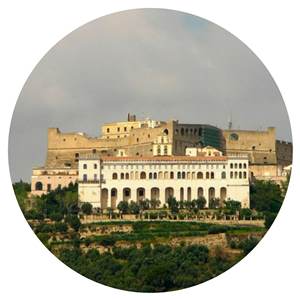
CASTEL SANT 'ELMO
How to reach : From Hotel il Convento reach Via Toledo and turn on the right. Walk for about 300mts. On the left you will see a little square: Piazzetta Augusteo where there is funicular station. Get funicolar and hop off at Fuga (last stop). At the right side of the funicular station Fuga there is an escalator. Get it and followdirection to reach other escaletors. At the end you will arrive in Via Annibale Caccavello. Go up hill
The castle sees its origin in 1275, during the kingdom of Charles I of Angiò. In this phase it had to have the structure of a medieval palatium. The Belforte, this was in origin the name of the Castle, rises in 1329 to want of Roberto of Angiò on the hill of the Vomero. During the reconstruction it was modified with defensive works, so much to be called castrum Sancti Erasmi, probably for the presence of a chapel devoted to Saint Erasmo. From the plaza of weapons and from the slopes it is enjoyed of a suggestive sight of the ancient center and the bay of Naples: from the ancient Neapolis to Partenope, with the hold loophole of Spaccanapoli
The Castle was not only used as point of defense during the revolt of Masaniello in 1799 but it was also used for imprisoning the revolutionary ones, acquiring a punitive function that has preserved for different years.
It was military zone up to 1976, year when the last restauration began, conducted by the Provveditorato to the Public Works with the intent to return it to the city as center of cultural activity. Very interesting are the underground jails and the terraces.
It can be visited in case of expositions.
Certosa Di San Martino :
But we cannot talk about the Castle Sant'Elmo without cite the Chartreuse of San Martin founded in 1325 by Charles duke of Calabria, that wanted it in a dominant position on the city. The first solution was an imposing Gothic construction of which few elements remain today in reason of a radical restructuring with Baroque style in XVII century. Some cracks with bows in Catalan style are still recognizable - which can be found in the ex-refectory probably used as passes foods and founded in a recent restauration. The Chartreuse was consacrated to St. Martino, bishop of Tours, probably for the presence of an ancient preexisting chapel. Toward the half part of XVI century, under the influence of the counter-reformation, the Chartreuse was renewed according to the most modern ideas. A splendid example of the seventeenth-century Neapolitan art is constituted from the Great Cloister, characterized by columns of order Dorico-Tuscan, from the little cemetery of the Carthusian monks, from the statues of the colonnade, from the busts of the saints Carthusian monks on the portals, from the false pit in the center and from numerous fruit trees. A smaller cloister, called Cloister of the Attorneys, constitutes the access to the gardens and to rooms of the National Museum; it has the same proportions of the Great Cloister, and it has at the middle a pit, made by Felice de Felice. The apartment of the Prior was decorated by famous Neapolitan painters, and endowed with a beautiful floor in brick and majolica pottery, still visible.
The monastery was suppressed in 1806 by French.
Today the Chartreuse entertains the National Museum of San Martino dedicated to the city history and with an ample, suggestive, exposure of cribs of the Neapolitan school.
Gardens of the Chartreuse go down from St. Martino along the hill of the Vomero, to reach tin Corso Vittorio Emanuele and from them you enjoy some most beautiful panoramas on the Bay of Naples.
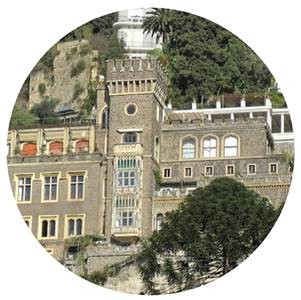
CASTELLO ASELMEYER
Come Arrivare : From Hotel il Convento reach Via Toledo and turn on the right. Walk for about 300mts. On the left you will see a little square: Piazzetta Augusteo where there is funicular station. Get funicolar and hop off at Fuga (last stop). Change with funicular of Chiaia (a couple of minutes on foot). Get funicular and stop in C.V.Emanuele. Aselmeyer Castle is on the right side of the funicular station.
History :
The grandiose construction, realized like a medieval castle, was built in reality between 1902 and 1904. Element of relief of the view from Via Caracciolo, the " castle " is a work of the English architect Lamont Young, it's the reason why, at first, it was called " Castle Lamont " was called.
The building is in Neo-Gotich style mixed with "Todoreschi" and Elisabethan elements, peculiar of English bourgeois residences. Initially the work was very criticized for the use of unusual lines not in harmony with the Neapolitan tradition. Currently the castle is turned to private residence and it is not visitable.
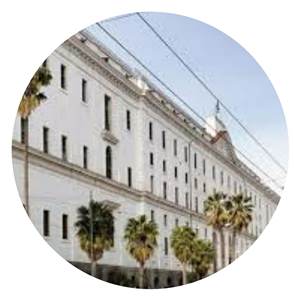
ALBERGO DEI POVERI ALSO CALLED PALAZZO FUGA - Piazza Carlo III
Designed in 1751 by Ferdinando Fuga for Charles of Bourbon's will, the building had to give hospitality to the poor of the city, dividing them into four "castes": women, girls, men and boy.
Just based on these distinctions, Fuga designed the structure in order to preclude any contact among the different categories of guests.
According to the project there had to be a long rectangular building, measuring 600 meters in length and 150m in width, composed of five aligned courts of which, the central one, should have host a church characterized by four aisles arranged in the shape of X.
As a metter of fact the work was interrupted in 1819, leaving the building deprived of the sides corresponding to the outer edges of the last two court. After more than a century and a half of neglect, in 2005, officially started the restoration work.
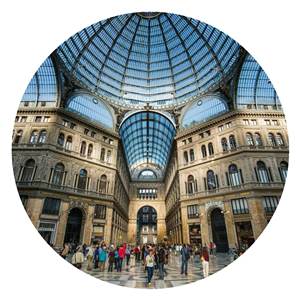
GALLERIA UMBERTO I - Via Toledo
In 1884, following the devastating cholera epidemic, whole overcrowded neighborhoods (Porto, Pendino, Mercato, Vicaria) were demolished and a committee was convened to consider the reconstruction of these areas.
The rebuilding of the area adjacent to Via Santa Brigida, was entrusted to the engeneer Rocco Emanuele, who designed four buildings connected by a large gallery of iron and glass, whose design was entrusted to Paul Boublée. The stained glass, with an area of 1076 square meters, forming four arms, which intersect at a large dome. Of the four entrances to the tunnel, the most valued is the one faceing the San Carlo Theatre, with a slightly arched portico and a façade emphasized with marble statues and niches.
The gallery was officially unvelied on November 10th, 1892 by Mayor Nicola Amore, and became in late '800 and early '900 the city's art and fashion centre.
After a period of decline during the period between the wars, is now a large and elegant city salon with beautiful shops, meeting places and offices.
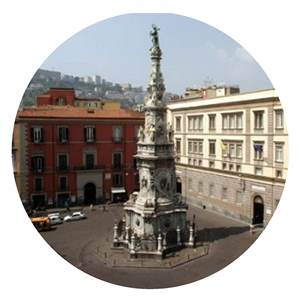
GUGLIA DELL' IMMACOLATA - Piazza del Gesu'
At the beginning, the obelisk at the center of the square, was actually an equestrian monument dedicated to Philip V. It was only in 1747 that, at the behest of the Jesuit father Pepe, was commissioned to the Architect Di Fiore the construction of the baroque spire.
It was the Jesuit father himself to refuse the King's subsidies, and to be able to pay the huge artists'fees thanks to popular collections. Even today, every Dec. 8, the Immaculate Conception Day, a ladder is leant against to the monument, to allow the cardinal offering a crown of flowers to the Immaculate.
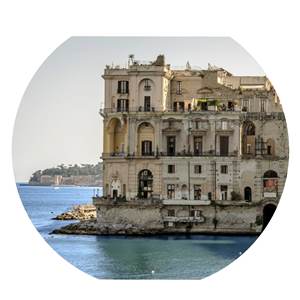
PALAZZO DONN' ANNA - Via Posillipo
The building of the palace was commissioned by the Viceroy Guzman, for his wife Anna Carafa and the construction was entrusted to Fanzago. Works began in 1642, but were never completed due to the sudden death of the woman. By the time the building assumed the countenance of a ruin, mingling with the many Roman ruins.
Nevertheless, the structure keep on being a predominant figure in the coastal landscape of the city.
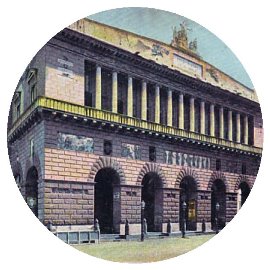
Via San Carlo, 98 tel. 081 7972 331
The oldest opera house in Europe. An unmissable stop for lovers of opera and ballet.
Location: Piazza del Plebiscito,less than 5 minutes on foot from Hotel il Convento
Piazza Calenda, 9 tel. 081 22 58 285. The house of Neapolitan music
Location: between Piazza Nicola Amore and Piazza Garibaldi,reachable by bus R2
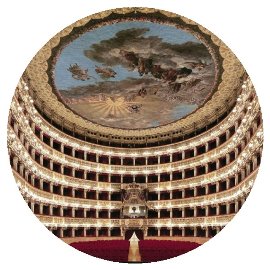
P.tta Duca D'Aosta, 263 tel. 081 40 56 60.
Location: Via Toledo, close by funicular Centrale. A couple of minutes on foot from Hotel il Convento
Via L. Giordano 64/72 tel. 081 578 49 78.
Location: Vomero. Get funicular centrale, hop off at Fuga (last stop). Walk along Via Scarlati and turn first on the left at the end of the pedestrian street.
Via Conte di Ruvo, 14 tel. 081 549 9688.
Location: close by Piazza Dante. 10 minutes on foot from Hotel il Convento or 1 stop metro line 1
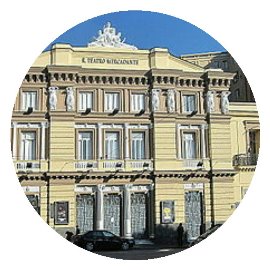
P.zza Municipio, 64 tel. 081 551 3396.
Location: less than 5 minutes on foot from Hotel il Convento, in the middle of Piazza del Municipio.
Via S. Domenico, 11 tel. 24 72 684.
Location: Vomero. Richable by taxi of by metro line 1.
Via Chiaia, 157 tel. 081 40 38 27.
Zona: In the middle of Chiaia district. 15 minutes on foot from Hotel il Convento.
Via Frediano Cavara,12/e tel. 081 5647525.
Location: close by Via Foria.
Via Montecalvario, 16 tel. 081 40 60 62.
Location: in the heart of Spanish Quarter. 250 mts only from Hotel il Convento.
.jpeg)
Via tondo di Capodimonte 13 - Basilica del Buon Consiglio tel. 0815441305
info@catacombedinapoli.it
ispettoratocatacombe@tiscali.it
Timetable Catacombs of San Gennaro: from Monday to Saturday 10am to 5pm. Ticket Catacombs San Gennaro + Catacombs San Gaudioso euro 9,00. Reachable by bus R4 from the city center.
.jpeg)
Piazza Sanità 14 - Basilica di Santa Maria della Sanità tel. 081 5441305
info@catacombedinapoli.it
Open everyday from 10am to 1pm. Ticket Catacombs San Gennaro + Catacombs San Gaudioso euro 9,00. Reachable by bus R4 from the city canter.
Piazzetta S.Severo a Capodimonte tel. 0817411071/081 5441305
ispettoratocatacombe@tiscali.it
Open everyday from 10am to 1 pm. Ticket euro 9,00. Reachable by bus R4 from the city center.
Piazza San Gaetano, 316 tel. 081 2110860.
open Monday to Saturday 10am to 5pm. Sunday 10am to 1.30pm. Ticket euro 4,00. In the heart of the historical center, limited traffic zone. About 20 minutes on foot from Hotel il Convento.
.jpeg)
Associations :
Napolisotterranea : Piazza San Gaetano, 68 tel. 081 296944. Guided tours every hour
Laes : Piazza Trieste e Trento. Tel. 081 400256. On appointment.
Galleria Borbonica: Vico del Grottone, 4
Tomb of Virgilio e Leopardi : Via Piedigrotta, 20 tel. 081 669390
Tomb of Jacopo Sannazzaro : Chiesa di S. Maria del Parto - Via Mergellina, 9/b tel. 081 664627
Traditional Pizzerias

PIZZERIA BRANDI - founded in 1780
Salita Sant'Anna di Palazzo, 1 tel. 081 416 928
It's here that was created the famuos Pizza Margherita
It's at less than 10 minutes on foot from Hotel il Convento
Via Cesare Sersale 1/3/5 tel.081 553 92 04
Located in the Forcella district, it's one of the most ancient pizzerias in Naples. Here you can eat only Margherita and Marinara.
PIZZERIA TRIANON DA CIRO CASA MADRE
Via P. Colletta, 42/46 tel. 081 553 94 26
Enjoy the real Neapolitan pizza
ANTICA PIZZERIA E RISTORANTE PORT 'ALBA
Via Port'Alba, 18 tel. 081 45 97 13
Close by Piazza Dante, at less than 15 minutes on foot from Hotel il Convento.
Via dei Tribunali, 32
In the heart of the ancient center, lies the historical seat of Pizzaria Sorbillo, one of the most famous pizza makers in the world.
Via Michelangelo da Caravaggio, 53 tel. 081 714 21 55
On the Posillipo hill we find the Pizzeria La Notizia. The family atmosphere, DOP products of Campania Felix and the skill of Enzo Coccia make this place an obligatory stop for pizza lovers
Pizza chefs new generation

P.zza Sannazzaro, 201/B
The union of tradition with innovation.
Pizzaiolo: Ciro Salvo.
Via Caracciolo, 13
Pizza with fine flours and garnished with 0 km products.
Pizzaiolo: Giuseppe Vesi
Via Partenope 1/B
On the seafront. It's famous for pizza mixed with sea water.
Pizzaiolo: Guglielmo Vuolo
Via Partenope 1
On the seafront. The famous Sorbillo pizza a few steps from the sea.
Pizzaiolo: Gino Sorbilloo

Via Speranzella, 110 tel. 081 0383486
Traditional Neapolitan cuisine and pizzeria. Famous its fish specialties. Reservations are recommended
Very close to the hotel. A very particular restaurant. After your meal, you'll remember not only the typycal neapolitan food, but also the wonderful people you meet there.
Largo Sermoneta, 34 tel. 081 667047
Traditional Neapolitan food.
Piazza Dante, 53 tel. 081 5499372
seafood cuisine

Via Santa Brigida, 71 tel. 081 5524072
Neapolitan traditional cuisine. Specialties: pignatiello di vavella.
Vico Giardinetti a Toledo,78 tel. 081 421257
Ancient Neapolitan cuisine.
Via Palasciano, 30 tel. 081 680519
Seafood cousine lovers.
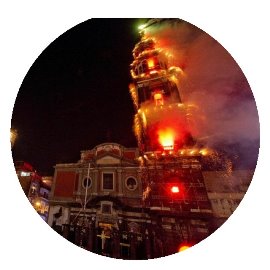
Fire of the Belly: 15 July - Piazza del Carmine
Miracle of San Gennaro: Saturday before the first Sunday of May, 19 Sept, 16 Dec - Duomo di Napoli
Fucarazzo ‘e Sant’Antuono (bonfire of Sant'Antonio): 17 Jan - Piazza del Carmine
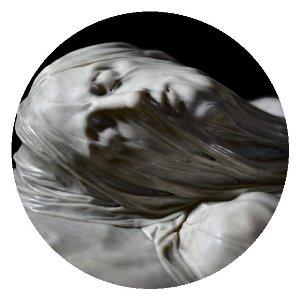
CAPPELLA SANSEVERO - Via F. De Sanctis, 19 Tel 081 5518470
The Sansevero of the Sangro' Chapel , called also "Saint Maria of the Pity of the Sangro" or " Pietatella", was built in 1590 as sepulchral chapel of the family.
To make this chapel a leg inevitable of your trip, are statues of the Demureness, the Disillusionment and the Veiled Christ.
The Demureness is the name of the funeral monument of Cecilia Gaetani of Aragon, mother of Mr. Raymond, dead in young age; the Corradini, to express the concept of the "veiled bashfulness ", carved a beautiful naked woman covered by a transparent veil that makes her totally indecent for the generosity of the opulent forms.
The Disillusionment, is the one of Antonio de Sangro, prince's father, dead in 1757, that, upset by the great pain for the death of his wife, he abandoned himself to a wandering and uneasy life discovering the "deception " and then retirind to monastic life surrendering the things of the world and the child Raimondo to his father Paolo. Francesco Queirolo represented a man (Antonio) that make him free from a net that envelops him, working in with only one marmoreal block.
The Veiled Christ is the synthesis of the whole chapel. Initially the sculpture, commissioned to the Corradini, it had to represent the Passion. At the death of Corradini, however, the sculputure was realized by Sammartino with the same suggestive techniques of the Demureness .
In the crypt you can find Anatomical Machines, two human bodies which the prince, with a prepared of his invention, has removed the " bodily wrap ", making of metal the whole system of the veins and the arteries. At present we don't know how he did it , who were the two miserable persons and if they were already dead or not.
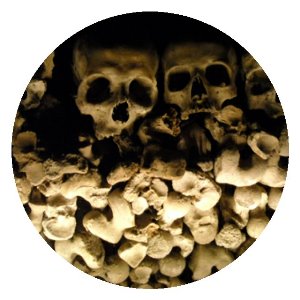
IL CIMITERO DELLE FONTANELLE - Piazza Fontanelle alla Sanità n.154
The graveyard is dug-out in the hill of Materdei. You can enter here fromthe little church of SS. Maria del Carmine. Up to 1836 it 3was the ossuary of the city. The greatest part of the skeletons go back to the terrible pestilence that, in 1656, decreased the number of the inhabitants from 400.000 to 100.000.
In 1952 Roger Peyrefitte wrote: "In two wide galleries, tall a dozen and long hundred meters, there were thousand and thousand of skulls and bones illuminated by thousand of candles. The bones are arranged for type and in geometric forms except some skulls that are in wood showcases, they are remains of "adopted souls".... It looks like an immense cathedral of the death. The unreal silence was broken only from the litanies of the old women that recited prayers for the souls of the Purgatory."
After a period of closing, the graveyard was reopened in 1872. From this period, the cult of the souls " pezzentelle " began. Every devotee adopted a skull, that corresponded to a soul "pezzentella ", that is a soul abandoned and without prayers, he gave him a worthy setup in a showcase and visits often him bringing flowers and candles and reciting "requiem aeterna ". In change the adoptive parent wanted graces and protection and if these didn't happen he abandoned the skull and he adopted another one.
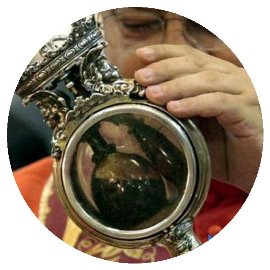
MIRACLE OF SAN GENNARO - Duomo di Napoli
The legend tell that Gennaro, bishop of Benevento, lived in the period of Diocleziano's Christian persecutions. In that period Sossio was bishop of Miseno. While Gennaro was going to Miseno for a liturgy, Sossio was imprisoned. So Gennaro, went to meet him at prison with his deacon Festo and the lector Desiderio. Here they were recognized as Christians and captured.
Martyrs were beheaded and their blood was put into ampullas from some faithfuls.It was the 305 d.c.. Between 413-432 the Bishop of Naples decided to give him a worthy grave moving his remains in the catacomb on the hill of Capodimonte.
On August 17th, 1389 there was the first news of the miracle of blood liquefaction. It was the Assunta's holiday and San Gennaro's relics were shown to faithfuls: the blood was fluid like if it was spurted the same day.
The miracle recurs 3 times per year: eve of the first Sunday of May (first translation), December 16th (anniversary of Vesuvio's eruption of 1631), and September 19 (death's date).
